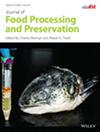Hybrid Deep Learning Algorithm-Based Food Recognition and Calorie Estimation
IF 2
3区 农林科学
Q3 FOOD SCIENCE & TECHNOLOGY
引用次数: 0
Abstract
Every individual requires some sort of system that informs them about portions and calories of food, as well as providing them with directions on how to consume it. In our study, we propose a hybrid architecture that makes use of deep learning algorithms to forecast the number of calories in various food items on a bowl. This consists of three major components: segmentation, classification, and calculating the volume and calories of food items. When we use a Mask RCNN, the images are first segmented. Using the YOLO V5 framework, features are collected from the segmented images and the food item is categorized. In order to determine the dimensions of each food item, we identify the items first. In order to calculate the quantity of the food item, the estimated dimension must be used. The calories are then computed using the food item’s volume. The aforementioned approaches, which were trained on the dataset’s food images, that correctly identified and forecasted a food item’s calories had an accuracy of 97.12%. To Provide directions on how to consume food is expected by individual and will be completed after knowing intake of volume of food.基于混合深度学习算法的食物识别与卡路里估算
每个人都需要某种系统来告知他们食物的份量和热量,并指导他们如何食用。在我们的研究中,我们提出了一种混合架构,利用深度学习算法来预测碗中各种食物的卡路里数量。这包括三个主要部分:分割、分类以及计算食品的体积和卡路里。当我们使用 Mask RCNN 时,首先要对图像进行分割。使用 YOLO V5 框架,从分割的图像中收集特征,并对食品进行分类。为了确定每种食品的尺寸,我们首先要识别食品。为了计算食品的数量,必须使用估计的尺寸。然后利用食品的体积计算卡路里。上述方法是在数据集的食品图像上训练出来的,正确识别和预测食品卡路里的准确率为 97.12%。提供如何食用食物的指导是个人的期望,并将在了解食物的摄入量后完成。
本文章由计算机程序翻译,如有差异,请以英文原文为准。
求助全文
约1分钟内获得全文
求助全文
来源期刊
CiteScore
5.30
自引率
12.00%
发文量
1000
审稿时长
2.3 months
期刊介绍:
The journal presents readers with the latest research, knowledge, emerging technologies, and advances in food processing and preservation. Encompassing chemical, physical, quality, and engineering properties of food materials, the Journal of Food Processing and Preservation provides a balance between fundamental chemistry and engineering principles and applicable food processing and preservation technologies.
This is the only journal dedicated to publishing both fundamental and applied research relating to food processing and preservation, benefiting the research, commercial, and industrial communities. It publishes research articles directed at the safe preservation and successful consumer acceptance of unique, innovative, non-traditional international or domestic foods. In addition, the journal features important discussions of current economic and regulatory policies and their effects on the safe and quality processing and preservation of a wide array of foods.

 求助内容:
求助内容: 应助结果提醒方式:
应助结果提醒方式:


